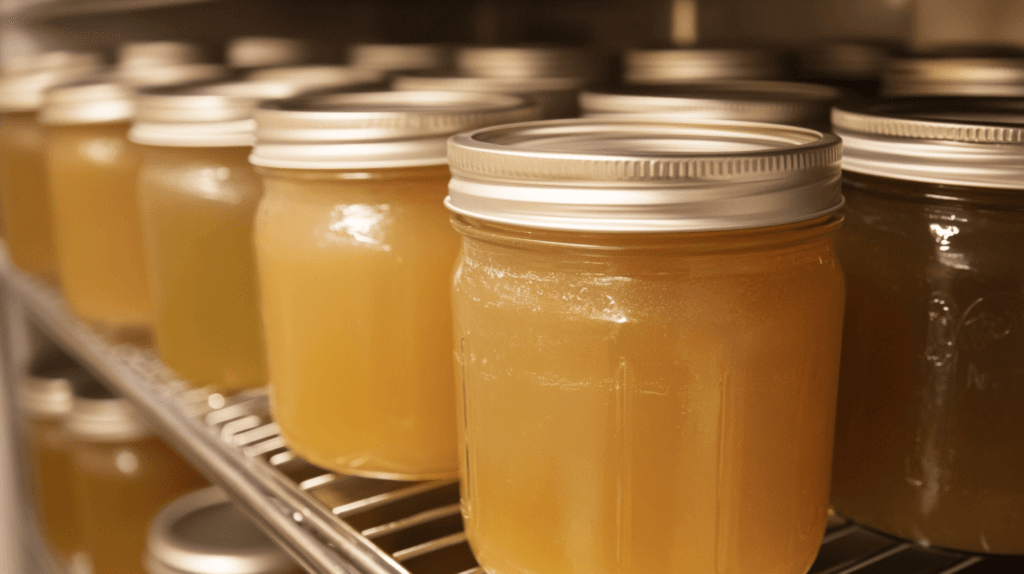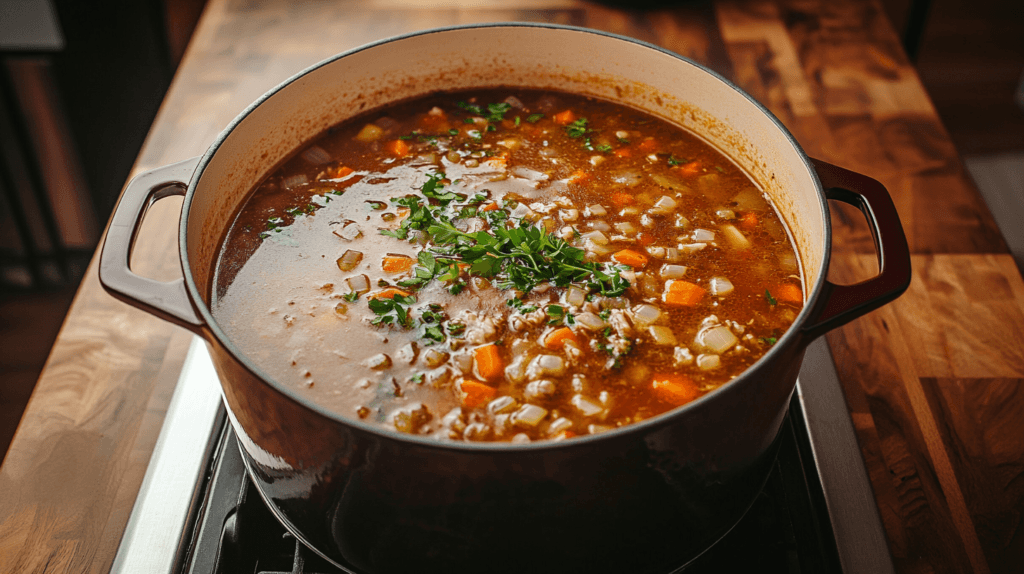Bone broth is a comforting, nutrient-rich liquid made by simmering bones, often with a variety of vegetables, herbs, and spices. It’s a staple in many kitchens, celebrated not just for its robust flavor but also for its impressive health benefits, such as supporting joint health, improving gut function, and boosting the immune system. But what vegetables are good in bone broth? Vegetables play a key role in enhancing its nutritional value, adding depth of flavor, and creating a well-rounded, satisfying result. This article explores the best vegetable choices, their unique benefits, and how to incorporate them effectively.
Table of Contents
The Importance of Vegetables in Bone Broth
Vegetables are the unsung heroes of a great bone broth. While bones provide the foundation with collagen and minerals, vegetables contribute essential vitamins, antioxidants, and subtle, aromatic flavors that elevate the broth to another level. They also balance the richness of the bones, making the broth more enjoyable and digestible.
The key to a perfect broth lies in choosing vegetables that complement the bones rather than overpower them. Let’s explore the ideal vegetables to create a delicious and nutrient-packed broth.
What vegetables are good in bone broth? Best vegetables

1. Onions: The Flavor Enhancer
The Importance of Vegetable
- How to Use: Cut them into quarters, leaving the skin on for a golden color, and toss them into the pot. Yellow or white onions work best, but red onions can add a slightly different flavor profile.
2. Carrots: Sweetness and Nutrition
Carrots are another classic addition to bone broth. Their natural sweetness balances the broth’s savory notes, while their beta-carotene content boosts vitamin A levels for improved eye and skin health.
- How to Use: Peel and chop them into large chunks. Organic carrots are recommended, as they often have a more robust flavor.
3. Celery: A Classic Addition
Celery brings a subtle herbal note and a pleasant bitterness that effectively cuts through the richness of the broth. Furthermore, it’s a staple in most broths not only for its flavor-enhancing properties but also for its contribution of essential vitamins, including A, C, and K.
- How to Use: Rinse the stalks thoroughly, chop them into medium pieces, and include the leaves for added flavor.
4. Garlic: A Nutritional Powerhouse
Garlic is famous for its immune-boosting properties and its ability to enhance the savory notes of any dish. It adds a mild spiciness and aroma to bone broth that’s hard to resist.
- How to Use: Use a few cloves, lightly crushed but not peeled, to infuse the broth with its unique flavor.
5. Parsnips: Subtle Sweetness
Parsnips are less common but highly effective in bone broth. Their earthy sweetness provides a unique twist, making the broth feel heartier.
- How to Use: Peel and slice them into thick rounds to prevent them from breaking down too quickly.
6. Leeks: A Delicate Flavor
Leeks are a milder alternative to onions, contributing a light, sweet flavor to bone broth. They also provide a good source of vitamin K and manganese.
- How to Use: Use the white and light green parts, slicing them lengthwise and rinsing thoroughly to remove dirt trapped between layers.
7. Turnips: Earthy Notes
Turnips add a peppery earthiness that complements the bones. They’re also packed with vitamin C and fiber.
- How to Use: Peel and cut them into quarters, using smaller turnips for a more delicate flavor.
8. Mushrooms: A Umami Boost
Mushrooms bring umami—a savory, meaty flavor—to the broth, enhancing its depth. They’re also rich in antioxidants and compounds that support immune function.
- How to Use: Add a handful of sliced mushrooms, like shiitake or cremini, towards the end of the cooking process.
9. Kale and Other Leafy Greens
Leafy greens like kale or spinach can be added for a nutrient boost, providing vitamins A, C, and K. They’re best added at the end of cooking to preserve their vibrant color and nutrients.
- How to Use: Chop greens into smaller pieces and stir them into the broth in the last 10 minutes of simmering.
10. Zucchini: Light and Fresh
Zucchini is a great option for adding a light and refreshing element to summer bone broths. It has a mild flavor and is high in water content.
- How to Use: Slice zucchini into thick rounds and add them mid-way through cooking.
11. Tomatoes: A Unique Twist
Tomatoes bring acidity and brightness, cutting through the richness of the bones and creating a vibrant, tangy broth. They’re also high in lycopene, a powerful antioxidant.
- How to Use: Use fresh tomatoes or a small amount of tomato paste for a rich, red broth.
Tips for Choosing Vegetables for Bone Broth
Selecting the right vegetables is essential for a flavorful and nutrient-dense bone broth. Here are some tips to ensure the best results:
1. Opt for Fresh, Organic Vegetables
Fresh, organic vegetables are ideal for bone broth because they are free from harmful pesticides and have a richer flavor. Organic produce often contains higher levels of vitamins and minerals, which translates into a more nutritious broth.
2. Focus on Seasonal Vegetables
Using vegetables that are in season ensures better flavor and affordability. For instance, root vegetables like carrots and parsnips are perfect for winter broths, while zucchini and tomatoes are excellent for summer broths.
3. Avoid Overripe or Wilted Vegetables
While bone broth is a great way to reduce food waste, avoid using vegetables that are overly soft, moldy, or discolored. These can negatively impact the taste and quality of your broth.
4. Consider a Variety of Colors
Incorporating vegetables of different colors not only makes the broth visually appealing but also ensures a diverse range of nutrients. For example, orange carrots provide beta-carotene, green kale offers vitamin K, and white onions contribute antioxidants.
5. Experiment with Ratios
Start with a 1:1 ratio of vegetables to bones, adjusting based on personal preference. If you like a lighter broth, add more vegetables; for a richer broth, prioritize bones.
Vegetables to Avoid in Bone Broth
While many vegetables enhance bone broth, some can overpower its flavor or affect its texture. Here’s what to avoid:
1. Cruciferous Vegetables (Broccoli, Cauliflower, Brussels Sprouts)
These vegetables have strong, sulfurous flavors that can dominate the broth. They also tend to break down into mush, clouding the liquid.
2. Potatoes
Potatoes can make the broth starchy and murky. If you enjoy the taste of potatoes, it’s better to use them in soups rather than in the broth-making process.
3. Beetroot
Beetroot can overpower the broth with its earthy flavor and bright red color. It’s best reserved for dishes where its distinct taste is desired.
4. Overly Soft Vegetables
Vegetables like cucumbers or very ripe tomatoes may disintegrate too quickly, making the broth cloudy and affecting its texture.
Preparing Vegetables for Bone Broth
Proper preparation of vegetables can make a significant difference in the flavor and clarity of your bone broth. Follow these steps for optimal results:
1. Washing and Cleaning
Wash all vegetables thoroughly to remove dirt, pesticides, or bacteria. Pay extra attention to leeks and celery, as they can trap grit between their layers.
2. Peeling and Trimming
Peeling is optional but recommended for vegetables like carrots and parsnips if they are not organic. Trimming off bruised or damaged parts ensures only the best produce goes into your broth.
3. Chopping
Cut vegetables into large chunks. Larger pieces hold their structure better during the long cooking process and are easier to strain out later.
4. Roasting for Enhanced Flavor
Roasting vegetables before adding them to the pot can deepen their flavor. Simply toss them in a bit of olive oil and roast at 400°F (200°C) until golden brown.
Step-by-Step Bone Broth Recipe with Vegetables
Here’s a simple yet flavorful recipe for making bone broth enriched with vegetables:
Ingredients:
- 2 lbs (1 kg) of bones (beef, chicken, or fish)
- 2 onions, quartered
- 3 carrots, peeled and chopped
- 3 celery stalks, chopped
- 4 garlic cloves, smashed
- 1 parsnip, sliced
- 1 leek, sliced and rinsed
- 1 turnip, quartered
- 1 handful of mushrooms (optional)
- 2 tbsp apple cider vinegar
- 10 cups water
- 2 bay leaves
- Fresh herbs (thyme, parsley, or rosemary)
- Salt and pepper to taste
Instructions:
- Prepare the Bones: Roast the bones in the oven at 400°F (200°C) for 30 minutes to enhance their flavor.
- Assemble the Ingredients: Place the bones, vegetables, and vinegar into a large stockpot. Add water to cover everything by about an inch.
- Simmer: Bring the mixture to a boil, then lower the heat to a gentle simmer. Let it cook for 12–24 hours to extract the maximum nutrients.
- Add Herbs and Seasoning: In the final hour of cooking, include bay leaves, herbs, salt, and pepper.
- Strain the Broth: Remove the bones and vegetables using a slotted spoon. Strain the broth through a fine mesh sieve to ensure a clear liquid.
- Cool and Store: Allow the broth to cool completely, then transfer it to glass jars or freeze it in portioned containers.
Health Benefits of Vegetable-Enriched Bone Broth
1. Rich in Collagen and Minerals
The combination of bones and vegetables creates a nutrient powerhouse packed with collagen, calcium, magnesium, and potassium, essential for healthy joints and bones.
2. Supports Immune Health
Vegetables such as garlic and onions are packed with antioxidants and immune-boosting compounds, making the broth a great remedy for cold and flu season.
3. Improves Digestion
Bone broth, combined with vegetables like carrots and celery, provides gelatin and fiber that support gut health and aid digestion.
Seasonal Vegetable Options for Bone Broth
Adding seasonal vegetables to your bone broth not only boosts its flavor but also ensures you’re using the freshest and most nutrient-rich produce. Here’s a guide to the top seasonal vegetables for bone broth:
1. Spring Vegetables
- Asparagus: Enhances the broth with a subtle, nutty flavor and increases its vitamin content.
- Peas: Fresh peas bring a subtle sweetness and vibrant green color.
- Leeks: A quintessential spring vegetable, perfect for a delicate flavor.
2. Summer Vegetables
- Zucchini: A subtle ingredient that adds a refreshing touch to summer broths.
- Tomatoes: Add a touch of acidity and a bright, tangy flavor.
- Bell Peppers: Provide a sweet and slightly smoky note.
3. Fall Vegetables
- Butternut Squash: Brings a creamy texture and earthy sweetness.
- Pumpkin: Brings a rich texture and a touch of natural sweetness to the broth.
- Parsnips: Perfect for hearty, warming fall broths.
4. Winter Vegetables
- Carrots and Celery: Classic staples that add depth and flavor to winter broths.
- Turnips and Rutabagas: Provide an earthy flavor with a hint of peppery spice.
- Kale and Spinach: Perfect for creating nutrient-rich broths during the colder months.
How to Store and Use Bone Broth

Proper storage helps keep your homemade bone broth fresh and nutrient-rich for future use. Here’s how to store and use it efficiently:
1. Storing Bone Broth
- Refrigeration: Keep bone broth in airtight glass jars or containers for up to 5 days.
- Freezing: Freeze the broth in portions using ice cube trays or freezer-safe bags. It will keep for up to 6 months in the freezer.
- Labeling: Be sure to label containers with the date to monitor freshness.
2. Using Bone Broth
- Soups and Stews: Use it as a flavorful base for hearty soups, stews, or chowders.
- Cooking Grains: Substitute water with bone broth when preparing rice, quinoa, or pasta to enhance flavor.
- Sauces and Gravies: Add it to sauces or gravies for a deeper, richer taste.
- Drinking: Warm a cup of bone broth and enjoy it as a soothing, nutrient-rich drink.
FAQs About Vegetables in Bone Broth
1. Can I Use Frozen Vegetables in Bone Broth?
Yes, frozen vegetables work well in bone broth and can be a convenient alternative. They may break down more quickly, but this doesn’t affect the flavor or nutrients significantly.
2. Do Vegetables Lose Their Nutrients During Cooking?
While some water-soluble vitamins may decrease during prolonged cooking, most of the nutrients from the vegetables infuse into the broth, making it highly nutritious.
3. Should I Strain the Vegetables After Cooking?
Yes, straining the vegetables ensures a clear, smooth broth. The nutrients from the vegetables will already be infused into the liquid.
4. Can I Reuse Vegetables from Bone Broth for Another Recipe?
Vegetables used in bone broth tend to lose their flavor and texture after prolonged simmering. While they can be blended into soups or sauces, they’re best discarded after broth-making. For guidance on what not to include in your broth, consider reading what not to add to bone broth.
5. What Is the Optimal Vegetable-to-Bone Ratio for Broth?
A 1:1 ratio of vegetables to bones is a good starting point. You can adjust it to suit your preference for a lighter or more robust broth.
6. Are There Vegetarian Alternatives to Bone Broth?
Yes, you can create a vegetable broth using a mix of vegetables, herbs, and spices. Although it doesn’t contain the collagen found in bone broth, it is still very nutritious. For more ideas, take a look at this chicken bone broth recipe guide for variations.
Conclusion
Bone broth is a versatile, nutrient-dense staple that is significantly enhanced by the addition of vegetables. For example, the natural sweetness of carrots and the savory umami of mushrooms each add distinct flavors and essential nutrients, elevating the broth to a new level. By selecting the right vegetables, preparing them carefully, and storing the broth properly, you can enjoy this nourishing dish year-round. To perfect your broth, consider learning what ingredients to avoid and exploring liquid vs. powdered bone broth.
Printable Recipe Card
Want just the essential recipe details without scrolling through the article? Get our printable recipe card with just the ingredients and instructions.

